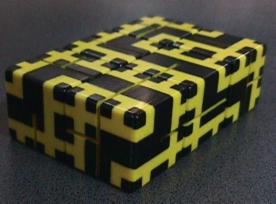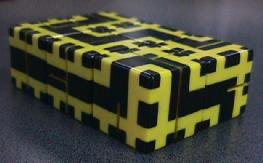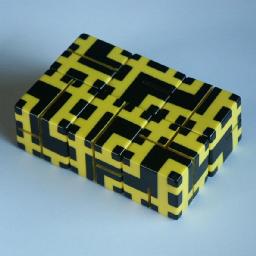Rubik's Maze
Rubik's Maze consists of 6 cubes. They are connected like one long string
in such a way that any face of a cube can be placed in any orientation onto
any face of an adjacent cube. On the surface of the cubes is a pattern of
thick black lines, separated by thin yellow ones. The aim is to place the
cubes in a 2x3 rectangle in such a way that the black lines on the outside
of the puzzle join up in a single long loop.
Rubik's Maze was invented by Jozsef Bognar and Ernő Rubik, 29 September 1982,
DE 3,145,032.
The number of positions:
If the cubes are numbered 1 to 6 in order, then the only restriction on
the placement of the cubes in a rectangle is that cubes 1 and 2 must
be adjacent, as must 2 and 3, 3 and 4 etc. This leaves only 4 distinct
ways to put the 6 cubes into a 2x3 rectangle. Each cube has 24 possible
orientations, giving a total of 4·246 = 764,411,904 rectangular positions
of which four positions are solutions.
Links to other useful pages:
Raymond Penner's page has the solution, and also a VRML object simulation for it.
Notation:
In the text below the cubes are numbered 1 to 6, where 1 is the cube which
has a loop on the surface around one corner.
Hints for finding a solution:
- Examine the lines on each cube and examine the number of dead ends.
The edges where the dead ends occur cannot become an edge of the 2x3
block.
- The dead ends of cube 6 restrict it so much that it must be one of
the central cubes in the 2x3 block, which leaves only one way of
arranging the cubes, viz. cubes 3 and 6 in the middle and the others
at the corners.
- The dead ends on the surface of cube 4 determine which sides are
hidden, therefore leaving it only two orientations.
- One of the orientations of cube 4 make it impossible to place cube 5
correctly, so cube 4 is then solved.
- Now cubes 3, 2, 1, 5 and 6 can be solved in that order, because they
only have one possibility left that does not cause a dead end with the
already solved cubes. Actually cubes 3 and 1 have two possibilities but
the faces on the outside of the 2x3 block are the same.
Solution:
|
|
|


Pictures kindly supplied by Corneliu Zavadovschi.
|




